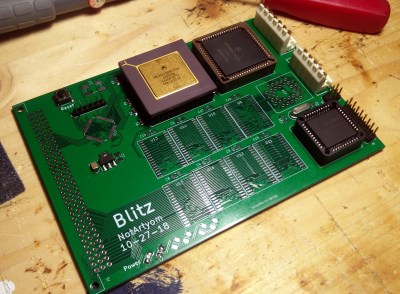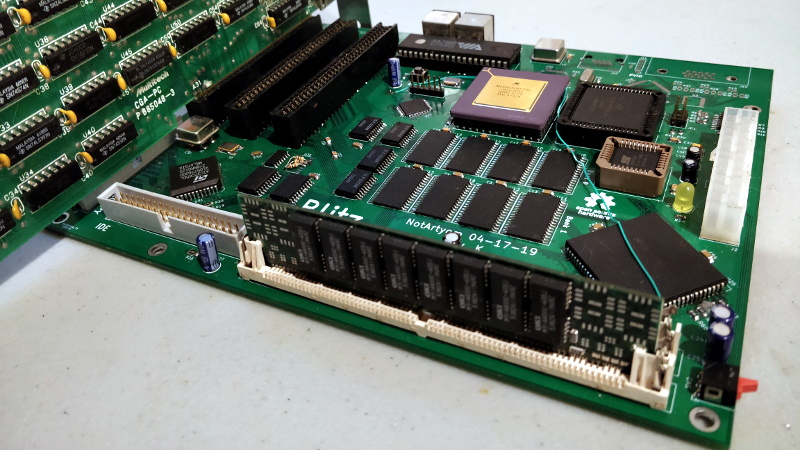We’re no stranger to home built Motorola 68000 computers here at Hackaday, but more often than not, they tend to be an experiment in retro minimalism. The venerable processor is usually joined by only a handful of components, and there’s an excellent chance they’ll have taken up residence on a piece of perfboard. Then [NotArtyom] sent in his Blitz, and launched the bar into the stratosphere.
Make no mistake, the Blitz isn’t just some simple demo of classic chips. The open hardware motherboard has onboard floppy, IDE, and PS/2 interfaces, with a trio of 8-bit ISA expansion slots for good measure. The Motorola 68030 CPU is humming along at 50 MHz, with 4 MB of RAM and 512 KB of ROM along for the ride. Designed to fit the Micro-ATX motherboard standard, you can even mount the Blitz in a contemporary PC case and run it on a standard ATX power supply.

As if the hardware wasn’t impressive enough, [NotArtyom] went ahead and created his own open source DOS-like operating system for it to run. Written in portable C, G-DOS can run on various m68k boards as well as ARM and PowerPC machines. It’s an incredible project in its own right. If you’re looking for something to show off your homebrew computer, you could certainly do worse than pulling down a copy of G-DOS. If you do port it to a new board, make sure to let [NotArtyom] know.
It’s taken [NotArtyom] three years to develop Blitz and G-DOS with his only goal being to better understand homebrew computers. He has no interest in monetizing the design or turning it into a kit, but instead hopes it will be a resource and inspiration for others with similar interests. Oh yeah, and he did all of this before he even graduated high school. If you weren’t questioning your life’s accomplishments before, now would be a great time to start.
Interested in building your own Motorola 68000 computer, but haven’t yet attained the wizarding level of [NotArtyom]? You could start with something a bit simpler like the 68k-nano, or if you’re really in a pinch, just dead bug a Dragonball 68328.
















Of course, there was a 68000 based computers described in a long series in Radio Electronics, the PT-68K , written by Pete Stark. An ISA compatible, it could use a lot of boards.
Peter Stark had an operating system, originally for the 6809, but SK-DOS for the PT-68K.
Great work! I love 68k homebrew and I wish I had the time to improve my Kiwi. Someday… :)
the kiwi was HUGELY inspirational for me, it convinced me to learn how to design and build homebrew computers. i’ve been meaning to ask you some questions and maybe peak at some of your code, but the forum on the kiwi website has been inaccessible for a good while now, it won’t let me sign up! cheers
Cool! F that, AMAZING! Now is anyone going to port software from old 68000 computers to this?
He’s a high school kid, give him a break. Gheesh!
At least he didn’t mention Kitler.
https://www.sun-sentinel.com/florida-jewish-journal/fl-jj-kansas-city-meteorologist-showcasing-kitler-hitleresque-cat-20210217-i2vfuyqnlrbxtb532bejnzms4q-story.html
Hm, after all these comments, I apologize.
Maybe it’s because I’m German, I have a slightly different perspective on this part of German’s history. To most Germans, these jokes are not understood as well as in other countries. Anyways, please disregard my comment.
Naturally the ONLY possible explanation is that this young man is a secret Nazi sympathizer who is using his homebrew computer to further his agenda.
I’m sure there’s a lot of hitlers in the world that weren’t related to the dictator. afaik, he didn’t leave any descendants alive so the suspicion of the name is unwarranted.
Timo Birnschein used the H-word! We must cancel him and anything he’s ever done!
Indeed.
It couldn’t possibly be History classes…
BTW Timo Dzhugashvili, the common usage of the word Blitz refers to something which moves very quickly, c.f. like lightning.
Truly a exceptional effort by a talented young man. Much kudos to him.
30 years ago this young man would have been hired on the spot to work at Sun Micro or Silicon Graphics.
Give the kid a break. Teenagers are notorious for tweaking uptight adults and for good reason,. Namely because uptight adults have a reaction all out proportion to the event. Think Barney Fife.
Yes Matthew Hopkins, we’ll get the gallows ready, since he must be guilty.
Hm, after all these comments, I apologize.
Maybe it’s because I’m German, I have a slightly different perspective on this part of German’s history. To most Germans, these jokes are not understood as well as in other countries. Anyways, please disregard my comment.
Shiny!
this reminds me of the m68k boards they used to use for the C335 intro to assembly programming at IU 20+ years ago! i think Ingo Cyliax made them. they looked like regular PCs on the outside but the motherboard was just like this one, and they had a pretty fancy bootloader but no OS. i really enjoyed them, it was a great way to learn close-to-the-metal programming in an academic environment. it was really a lot like programming in assembly for DOS but the m68k instruction set is much more aesthetically pleasing, and i think does a better job of preparing people for modern RISC instruction sets.
they later replaced them with more traditional SBCs, just a regular windows PC sitting beside a commodity m68k devkit with just some blinkenlights. i really think that was a big shame, because it erects a barrier in the student’s imagination, here is embedded development on one side of the wall and PC development on the other side of the wall. the old PC-looking m68ks really got across the idea that you could write something ‘real’ while also avoiding all the layers-within-layers of modern PC development.
Reminds me of a Commodore Amiga.
Wonderful Computer !!! Very nice
I just got some 68010s (supposedly, could be remarked) in the mail and wow I guess the gauntlet has been thrown. I was hoping to learn at least how to set up an MMU with this build. But hey, the more m68k projects out there, the more to learn from!
I have a couple dozen MC146805 chips sitting around.
I spent a few hours last week trying to find out what I need to build them into a useful circuit.
I’d expect a port of OS/9 68K to be next.
Beautiful :-)